How to Select Traction Motor for your EV Based on its Characteristics

Motors are the most essential part of any Electric Vehicle(EV). These are responsible for utilizing the chemical energy stored in the cells and converting it to rotational energy thus driving the wheels and causing the movement of the vehicle, hence these motors are also called traction motors.
In this article, we will be reading about different types of traction motors used in Electric Vehicles and learn about their characteristics. We will be comparing the characteristics and see which traction motor you need to use in your next Electric Vehicle.
Features of a Best Traction Motor
The most important features for an EV motor are efficiency, torque, cost, power to weight ratio, and reliability. The efficiency of an EV motor and the motor controller has a direct impact on the vehicle’s weight because the lost power must be compensated by a bigger battery which will impact the total weight of the vehicle. Therefore, it is fair to say that the overall performance and efficiency of an EV are primarily determined by the type of motor driver used. Hence it is essential to compare the torque-speed characteristics and power-speed characteristics in order to select the best traction motor.
Types of Motors used in EVs
Motor technology has come a long way since the first DC motor, the refinement in power electronics has also paved the way for more efficient and more powerful motors. EVs use various types of motors depending on their propulsion system. Motors can be categorized based on the type of current required such as DC motors and AC motors. Furthermore, the motors can be classified based on the type of their construction or if permanent magnets are present or not. Some common types of motors used in EVs are BLDC motor, Permanent Magnet Synchronous Motor (PMSM), Induction motor(IM), Switched Reluctance Motor (SRM), Synchronous Reluctance motor, etc.
DC Series Motor
The DC series motor, which is also known as the brushed DC motor is the most basic type of motor and has been widely used since the 1900s. The motor works when the electrical current is passed through its coils which are arranged within a fixed magnetic field. This motor is simple to control and has a high initial torque capacity making this motor a good choice. It uses brushes and commutators for working. By ensuring the direction of current the rotation of the motor can be controlled. But the major drawback is that the brushes tend to wear out fast requiring regular maintenance.
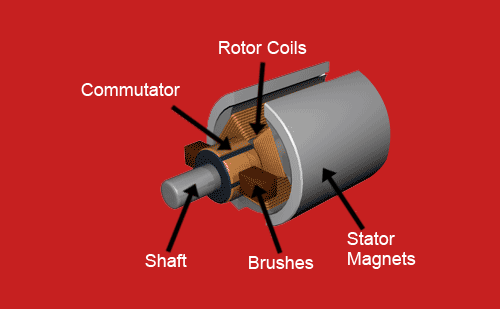
The characteristics of the DC series motor is shown below:
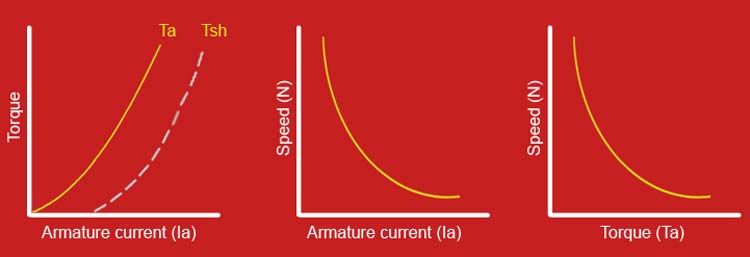
The brushed DC motors are not preferred in personal EVs such as scooters or cars due to their low efficiency, bulky size, and need for frequent maintenance. But are still popular in applications requiring high torque and load-bearing capabilities. Hence, the DC series motors are widely used in Indian Railway locomotives, cranes, heavy equipment, etc.
Advantages of DC Series Motor
- Very high starting torque
- Easy to control
- high load capacity
Disadvantages of DC Series Motor
- Low efficiency
- Bulky in size
- Requires frequent maintenance
Application of DC Series Motor
Indian Railway locomotives, cranes, heavy construction equipment, etc.
BLDC Motor

Brushless Direct Current Motors (BLDC) is also known as electronically commutated motor. These motors are one of the most common motors used in the EV industry. BLDC motors do not have brushes and therefore require very low maintenance compared to the DC motors, but unlike the brushed DC motor which has a simple operation, driving a BLDC motor requires complex motor controllers.
These are extensively utilized in a variety of applications owing to benefits such as low rotor inertia, compact construction compared to other motors with the same power rating and higher efficiency. BLDC motors have low losses since they use permanent magnets in the rotor and offer quicker reactions making them perfect for EV application, especially for 2 wheelers.
The torque-speed curve of a BLDC motor is shown below:

From the above torque-speed curve, it is clear that the torque of the motor decreases linearly with the increase in speed. The motor has a very high starting torque but provides a low torque at a higher speed.
Types of BLDC Motors
Based on their construction and design, there are two types of BLDC motors: inner rotor design or hub motor and outer rotor design or BLDC outrunner motor. The basic architecture of inner rotor and outer rotor brushless motors differs significantly. As we know that the magnets are used to spin all brushed and brushless motors. The rotor is the component that spins and holds the magnets while the stator's job is to produce a charge that repels or attracts the magnets, causing the motor to spin. The stator is on the exterior and the rotor is on the inside in a hub motor while the outer rotor has a completely opposite arrangement. The below image shows a hub motor and the components of a hub motor.
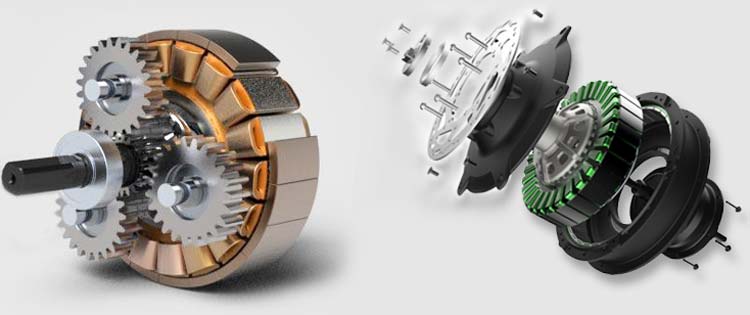
Advantages of BLDC Motor
- Brushes are not required.
- higher torque compared to other motors at the same current and voltage.
- Extremely high power density.
- Extremely efficient.
Disadvantages of BLDC Motor
- Low torque at higher RPM
- Requires an external motor controller
- Expensive
Induction Motors
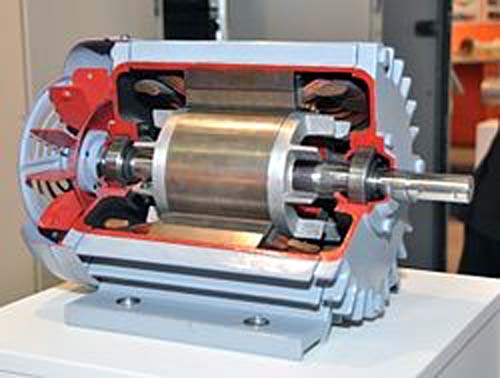
The induction motor (IM) is also known as an asynchronous motor. There are basically 2 types of IM, a single-phase induction motor and a three-phase induction motor. Single-phase induction motors (SPIMs) are still not widely used in vehicles due to their problematic starting, low-speed operation complexity, and other control disadvantages. Hence only the 3 phase IMs are used. These motors are called induction motors because the electric current in the rotor required to create torque is acquired by electromagnetic induction from the stator winding's revolving magnetic field. There are 2 types of induction motor based on the type of its rotor. An induction motor's rotor can be either a squirrel cage rotor or a wound-type rotor. The IM runs at a speed slower than their synchronous speed, hence, the induction motors are also known as asynchronous motors. The Induction motors are preferred because of their simple design, great dependability, robustness, ease of maintenance, low cost, and ability to operate in a variety of environmental situations. In case of inverter failures, IMs may naturally de-excite, which is a significant safety benefit for EVs. IMs' field-oriented vector control is standardized in the industry.
The major disadvantage of IM motors includes lower efficiency compared to Permanent Magnet(PM) Motors or BLDC motors, greater power losses (due to cage losses), and a poor power factor. In the constant power operation area, the weakening of the flux can be employed to increase the speed range. Some vehicles utilize dual inverter technology as dual inverters can also be used to expand this region.
The below image shows the torque-speed characteristics of an Induction motor.

The induction motor requires an inverter to convert the energy stored in the battery to an AC power, a picture of the Tesla Model 3 inverter is shown below:

The inverter is mounted in the motor housing of a 3 phase induction motor. The below picture of the induction motor is taken from the youtube video by Weber State University.

Advantages of Induction Motor
- Very high efficiency
- Simple design
- Robustness and can be used in harsh environment
- Requires low maintenance
- Low-cost motors
Disadvantages of Induction Motor
- lower efficiency compared to PM motors or BLDC motors
- Higher power losses
Application of Induction Motor
Used in Tesla Model S and Tesla Model X
Permanent Magnet Synchronous Motor (PMSM)
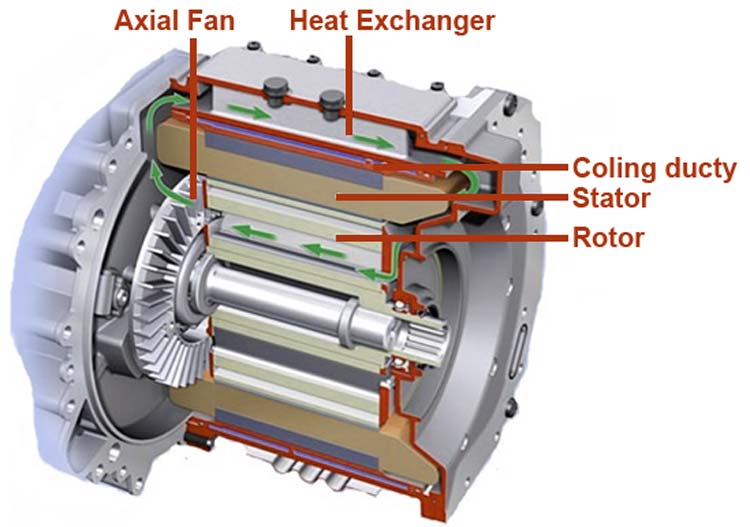
As the name suggests, PMSM is an AC motor that uses a permanent magnet in its construction. It is a hybrid of a brushless DC motor and an induction motor. Brushless permanent magnet synchronous motors (PMSMs) offer a high level of dependability and efficiency. They also have a greater torque, lower frame size, and no rotor current than AC induction motors, all of which are benefits over AC induction motors (AICMs). Because there is no stator power allocated to magnetic field creation, it has a better power density than induction motors with similar ratings. Therefore, the main benefit of a PMSM is that it can help you in reducing the size of your design without sacrificing torque, thanks to its excellent power-to-size ratio. PMSMs are commutated similarly to BLDC motors, however, the waveforms used need to be sinusoidal due to the structure of the windings.
PMSM employs vector control methods to reach this level of control. Field Oriented Control(FOC) is a term used to describe vector control approaches. The vector control technique works by decomposing a stator current into two parts: a magnetic field generator and a torque generator. After the breakdown, both components can be controlled independently.
The speed torque curve of a PMSM is shown below:
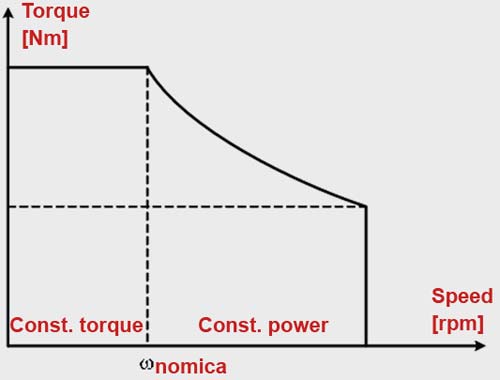
From the above graph, it can be inferred that the BLDC motors have a constant torque at a lower speed while it has a constant power region.
Advantages of PMSM
- It provides greater efficiency at high speeds
- It is far easier to maintain and install than an induction motor.
- It is capable of retaining full torque at low speeds.
- It provides smooth torque and dynamic performance
Disadvantage of PMSM
- Difficult to control
- Higher cost
Application
- Used in Nissan leaf
Switched Reluctance Motor (SRM)
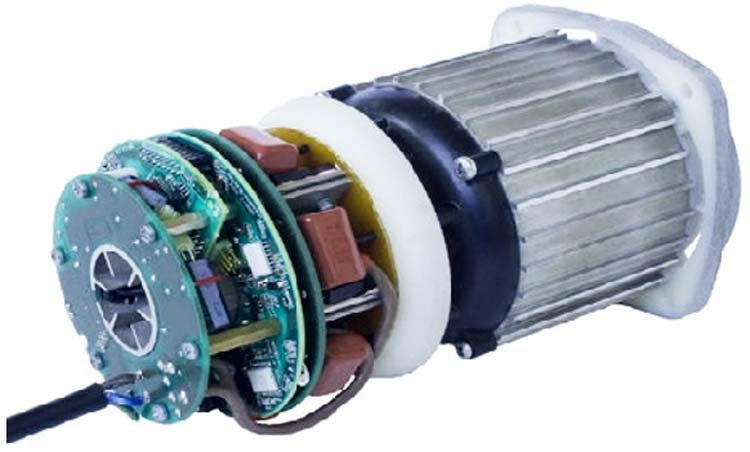
A switched reluctance motor creates torque by altering its magnetic reluctance. It has salient poles and windings similar to a brushless DC motor's stator, but the rotor is constructed of steel cut into salient poles with no magnets or windings. Unlike normal brushed DC motors, the power is sent to the stator windings rather than the rotor. When the magnetic field created by the stator and rotor varies, SRM functions via alternating currents in the stator. Switched reluctance motors contain fewer rotor poles than stator poles to avoid a circumstance when both rotor and stator poles match up together and no torque is produced.
Because of its control flexibility, simple structure, low cost, and great efficiency, a switching reluctance motor has several advantages over other types of electric motors. Due to the absence of a permanent magnet or winding in its rotor, an SRM is suitable for extremely high-speed applications and can sustain high temperatures. It also results in a durable and simple construction as well as a low manufacturing cost. Similarly, if a failure develops in any one winding or phase, the motor can still operate, but at a lower load. The biggest problem with SRM is its non-linear properties due to magnetic saturation, making precise torque control difficult.
The below image shows a speed torque curve of a Switch Reluctance Motor.

From the above image, we can see that the SRM has a constant torque and constant power mode similar to PMSM but unlike PMSM where the torque declines to zero instantly after reaching the threshold, the SRM has a gradual decline even at higher speed.
Advantages of SRM
- Cheaper than other motors
- Simple to design and repair
- SRM motors can operate at harsher conditions compared to PMSM or BLDC motors.
Disadvantage of SRM
- Controlling torque is difficult
- High level of noise
- High level of vibration.
Application of SRM
Honda Civic Hybrid Electrical Vehicle
Conclusion
There are different types of motors available in the market, each of the motors have their own advantages and disadvantage. The Brushed DC motor provides simple control and high initial torque but has lower efficiency and requires regular maintenance. The BLDC motor is extremely efficient and is also available in a hub-type enclosure which can be directly used inside a wheel reducing the additional cost and weight of the mechanical transmission, but the control mechanism of a BLDC is very complex. The Induction motor is a low-cost motor with high reliability and robustness but it is similar to a BLDC motor, it also requires an inverter as it is an AC motor. Furthermore, it has a lower efficiency than the BLDC motor. Then we have PMSM which is a cross between a BLDC and an IM. PMSM provides high torque and has a very high power to weight ratio but requires a very complex control method to drive the motor. There is Switched Reluctance Motor which is capable of working in harsh environments and is simple to design while being cost-effective but its non-linear characteristics make precise torque control challenging. So, we can say that there is not a one-fit solution for all the applications. All the motors have their own use cases and selection of motor can only be done after careful consideration of the application and its requirement. I hope that you enjoyed reading the article and if you have any questions, please feel free to comment down below.




